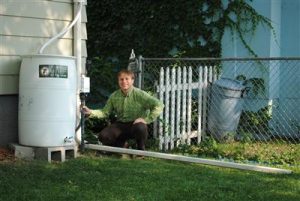
Credit: Eric Booth
September 17, 2012
By Aaron R. Conklin
Stroll through any standard-issue suburban subdivision and you’ll likely key in on the familiar hallmarks: large homes with large driveways, lots of green space, a general lack of sidewalks. You probably won’t see what Steven Loheide, a professor at the UW-Madison’s College of Engineering, sees: how the design of these lots is affecting the area’s water budget.
With the support of the Water Resources Institute, Loheide and a small team of UW-Madison students are trying to document how stormwater runoff and groundwater recharge are affected by what property owners do (and don’t do) on a lot scale. Loheide calls the project “urban ecohydrology.”
Typically, hydrologists think of water budgets in terms of a lot’s impervious area—more impervious area equals more stormwater runoff. Loheide’s research is looking at something a little more small-picture: the connectivity of that impervious area. Things like whether the home’s downspout connects directly to the storm sewer system, whether the sidewalk is immediately adjacent to the curb or whether there’s a greenspace separation. Even the slope of the driveway, and whether it encourages increased runoff matters.
Working with UW-Madison students Jeffrey Miller, Carolyn Voter and Sam Zipper, Loheide has installed moisture sensors in the lawns of several lots in both urban and suburban settings. The sensors are stationed in strategic areas—near a sidewalk, away from a downspout—to better outline the differences in moisture dynamics.
“The most interesting part of the project is learning how very small changes to the layout of a yard can have a large impact on the urban water balance,” says Miller, a graduate student from Pittsburgh. “It would be exciting if our work could contribute to the development of parcel-scale strategies for controlling surface runoff and groundwater recharge in urban areas.”
Variables like lot configuration, soil properties and local climate will all likely affect the data findings. Even so, Loheide thinks the results could be surprisingly counterintuitive.
“Everyone thinks that with urbanization, you increase stormwater runoff, and that’s true.” Loheide said. “But you also think that you decrease groundwater recharge. I’m not certain that has to be true in all cases.”
Depending on whether precipitation that falls on a roof is directed to pervious portions of the lot, the water may penetrate past the root zone, creating focused recharge.
“In a perfect world, you could design a lot where you have no stormwater runoff,” Loheide said.
Loheide’s team is still collecting and uploading data from the test sites. The next step is also the project’s ultimate goal: developing archetype models that have all the real-world system characteristics of a typical home in a particular setting (high urban density, subdivision, etc.).
“Within that we can then experiment with different amounts of connectivity between downspouts sidewalks and driveways,” said Loheide. “We want to see how different arrangements would affect the water balance of that archetype lot.”
Getting there is a complicated process that involves coupling models of surface runoff with subsurface moisture flow. When the mathematical formulas have been sorted out, Loheide’s team will have both 2D and 3D models of water flow that could change the way developers and homeowners think about water budgets—by getting them to think about the hydrologic process in the first place.



